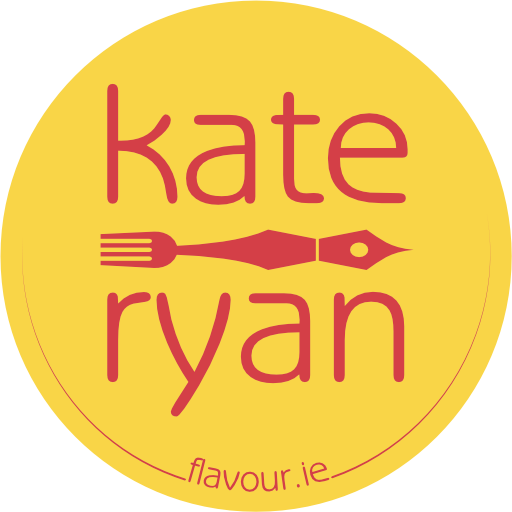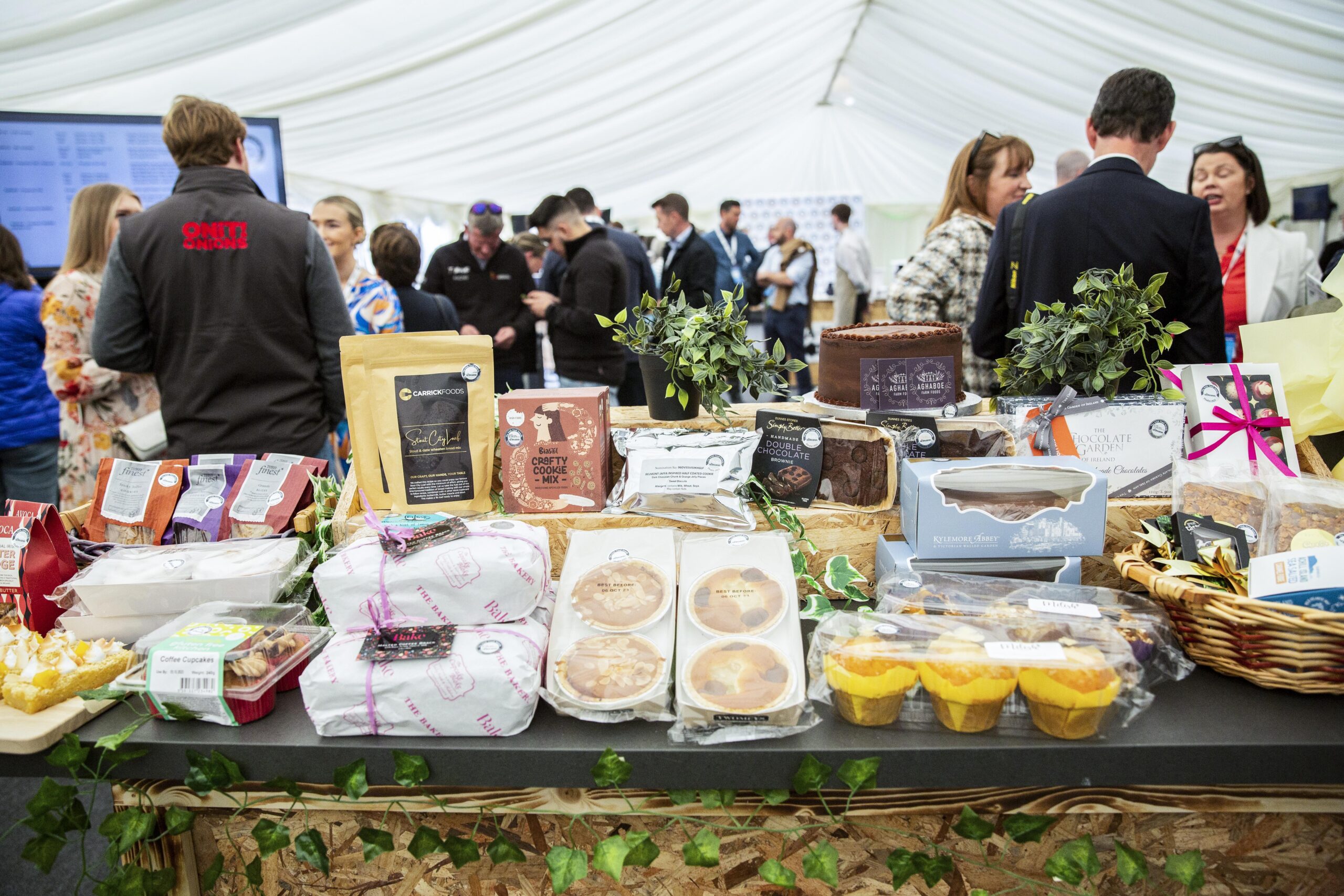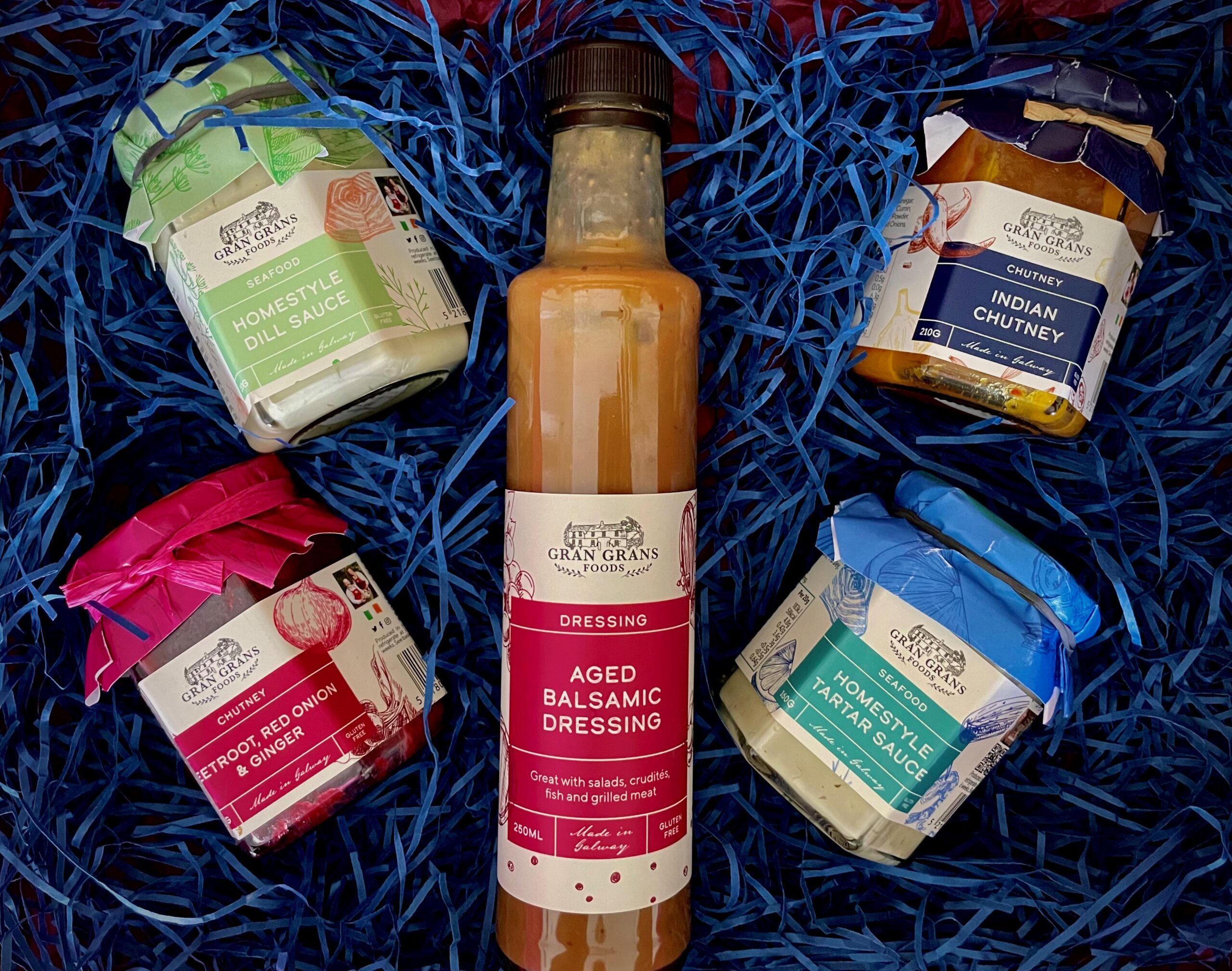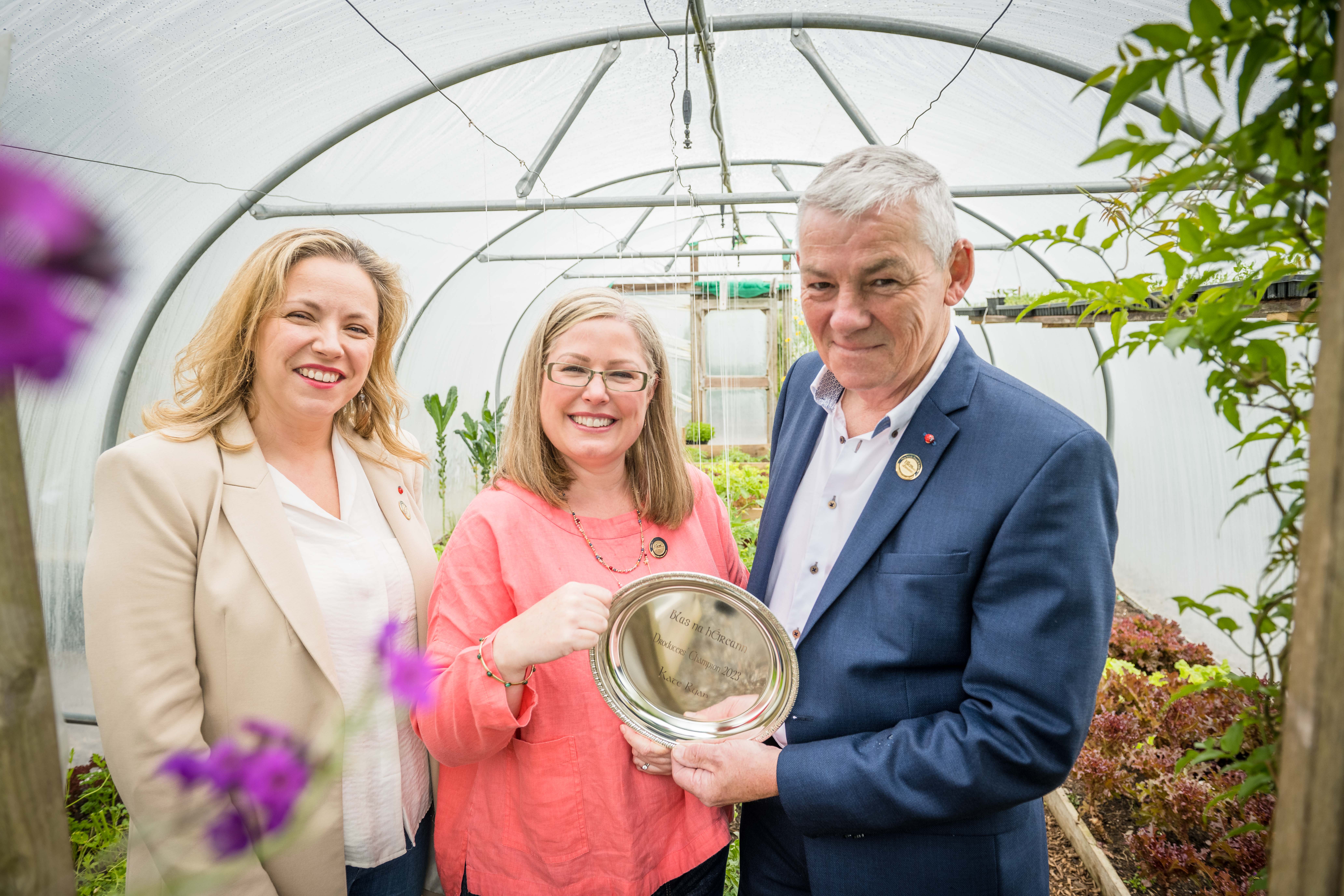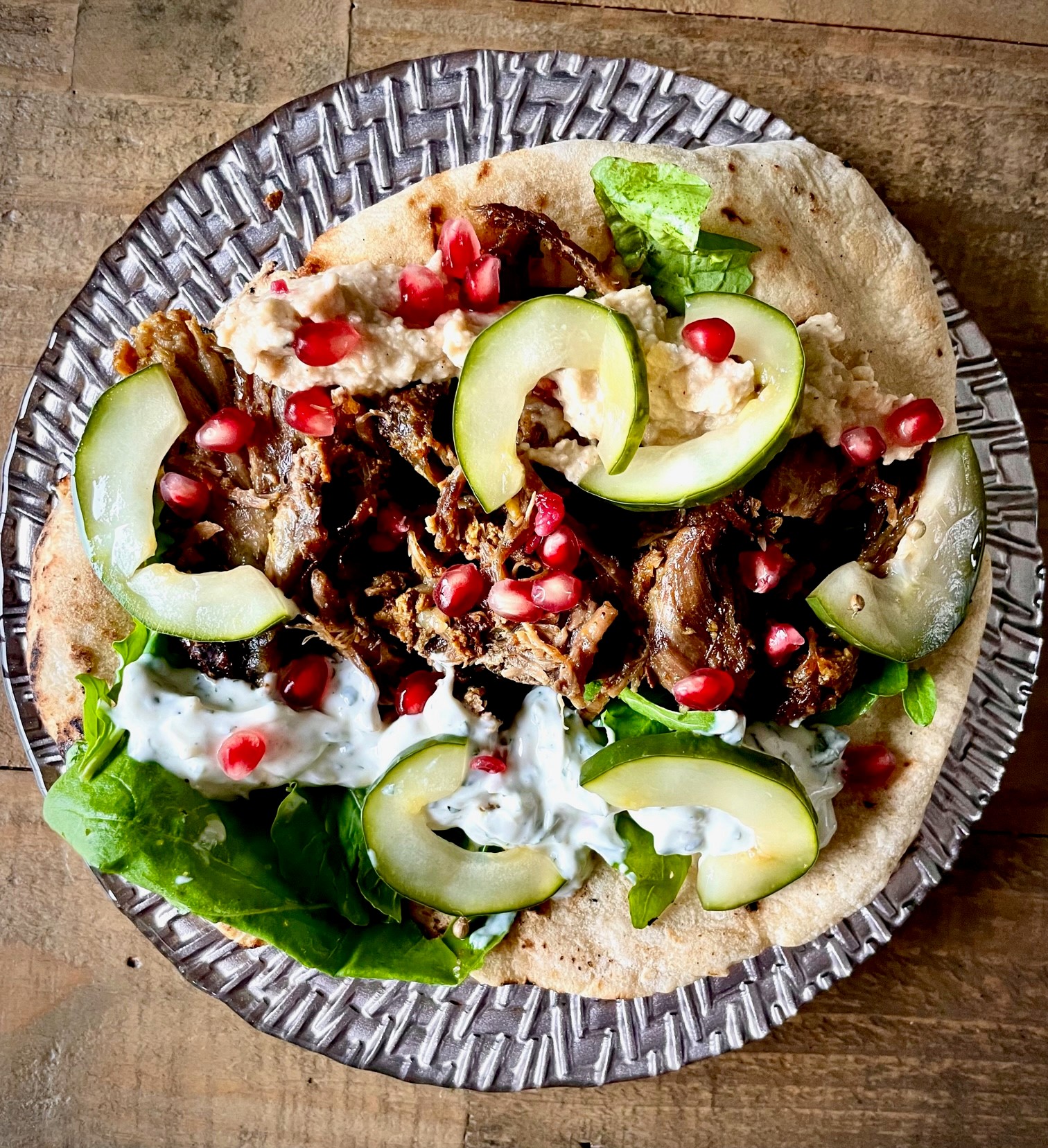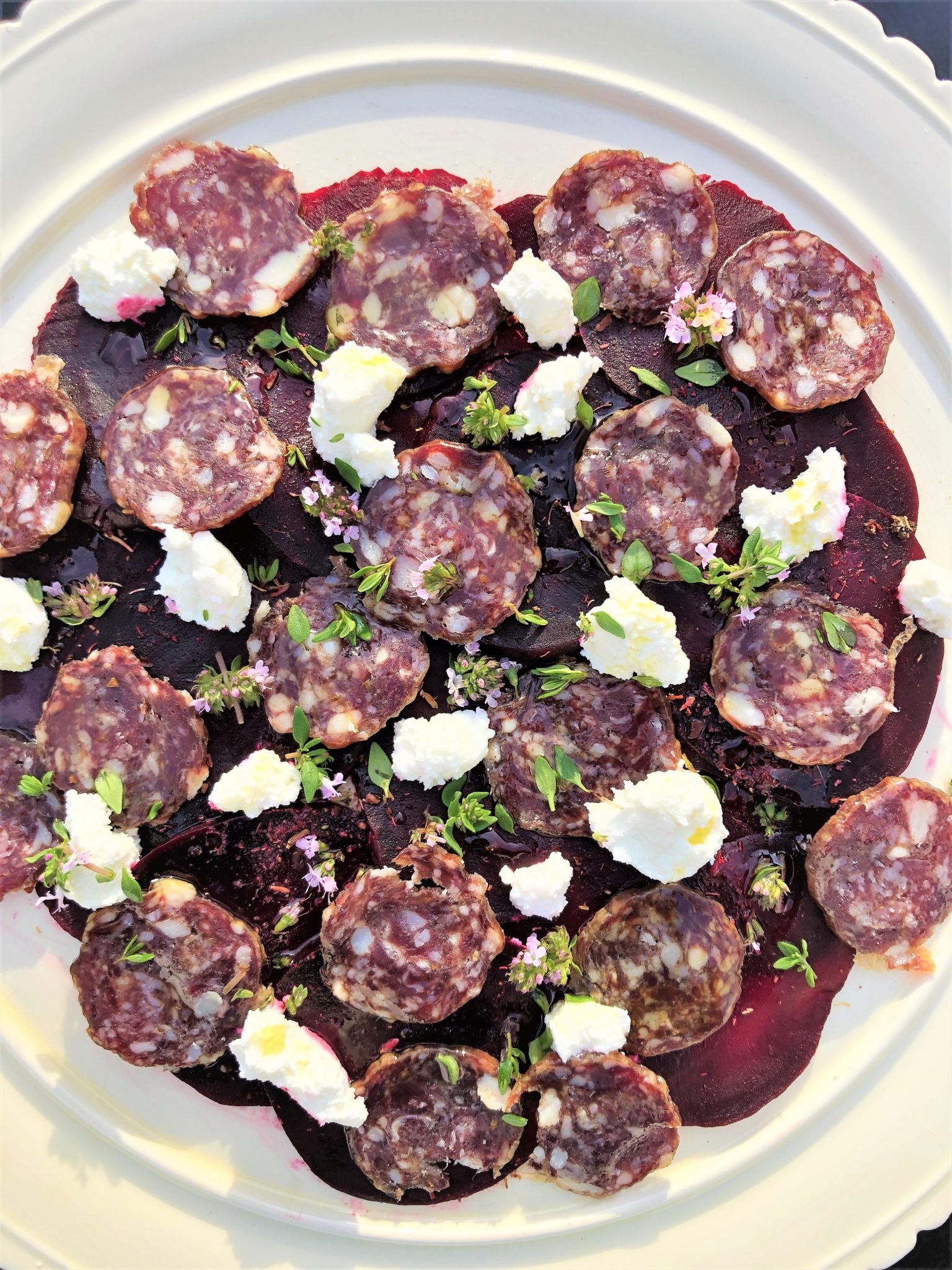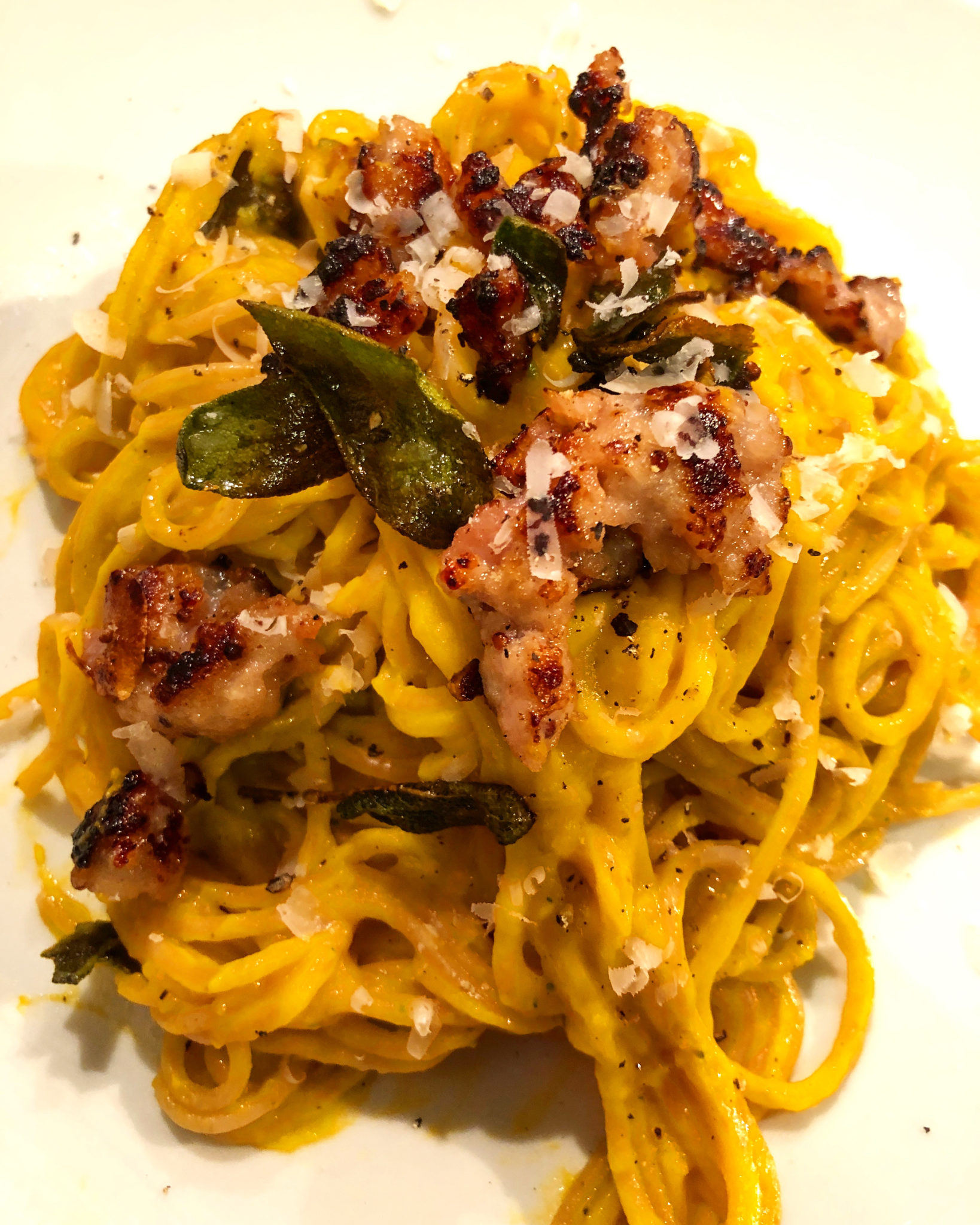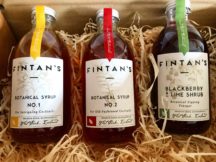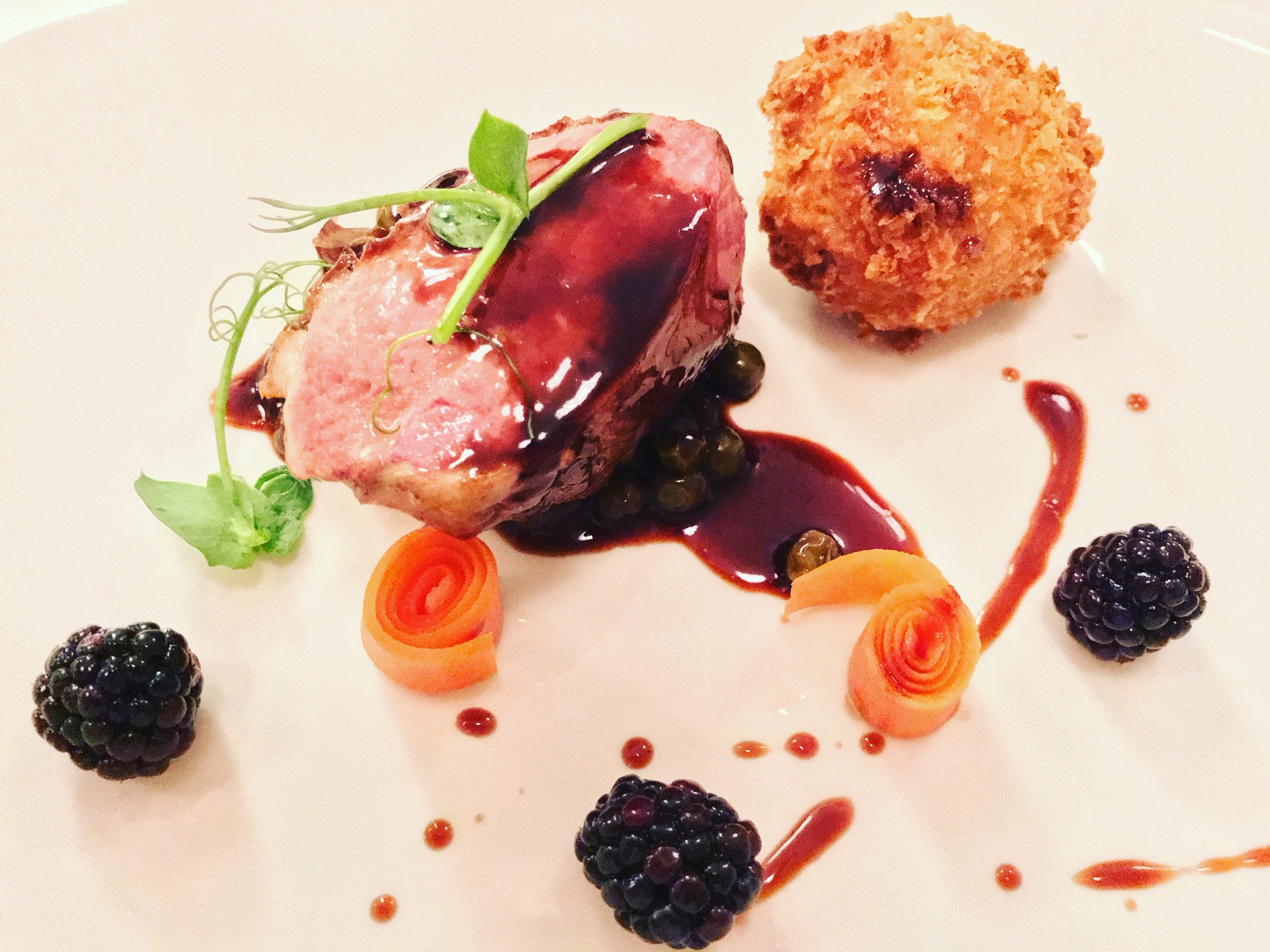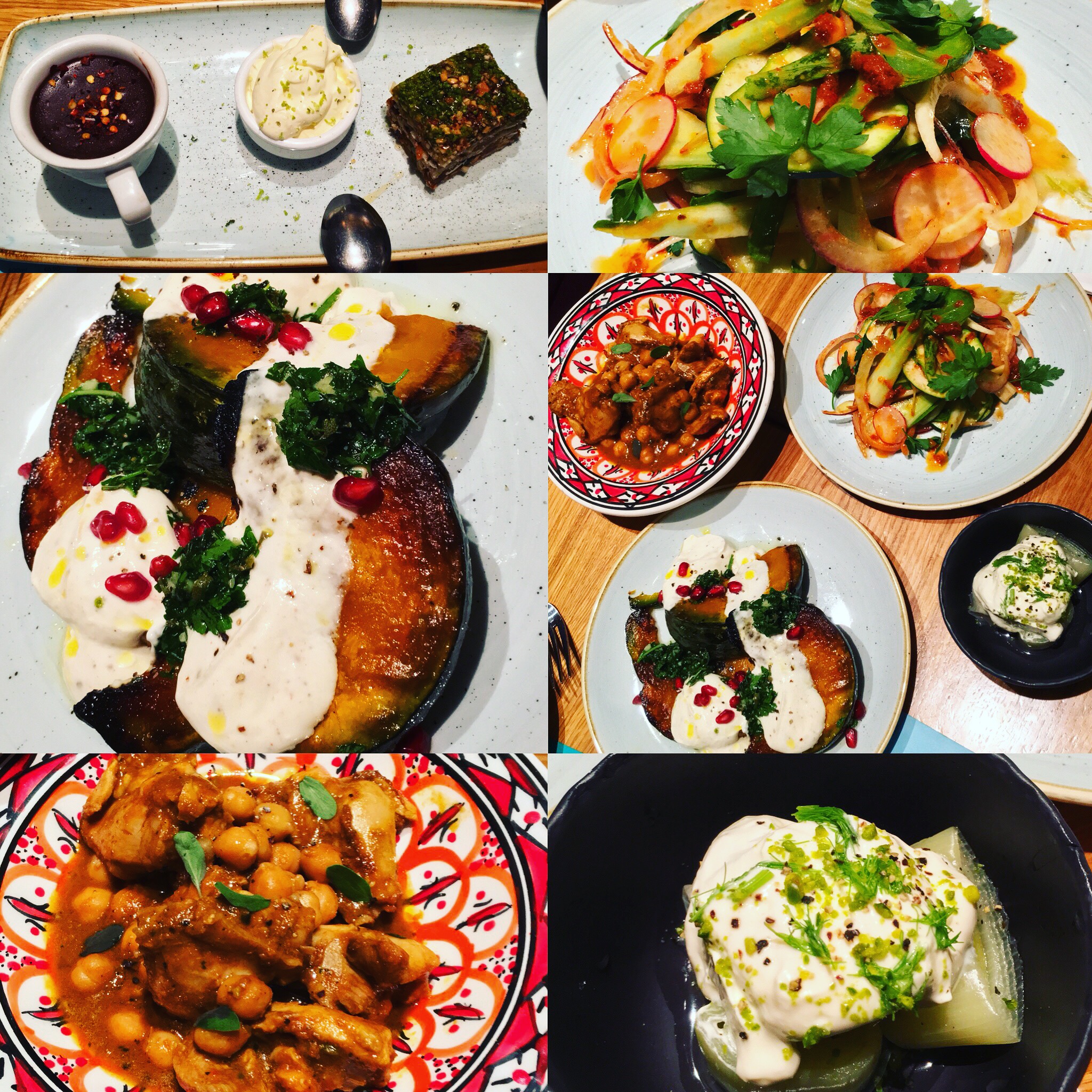This years’ Blas na hÉireann awards were very special, because this year I was in attendance not just for the craic, but as the Irish Food Producers’ Champion 2023…
Continue reading “Blas 2023 – Where Every One is a Winner!”Flavour Taste Lab – Gran Grans Foods
For this Taste Lab, I worked my way diligently through a #gifted hamper of condiment goodies, and was delighted with the quality!
Continue reading “Flavour Taste Lab – Gran Grans Foods”Kate Ryan, founder of Flavour.ie, is announced Blas na hÉireann Producers’ Champion 2023
Kate Ryan, award-winning food writer and founder of Flavour.ie, named Blas na hÉireann’s Producers’ Champion for 2023
Continue reading “Kate Ryan, founder of Flavour.ie, is announced Blas na hÉireann Producers’ Champion 2023”Adventures with Achill Mountain Lamb
Since 1962 on Achill Island, the Calvey family has reared their mountain lamb on the wild Mayo coast producing meat of exquisite taste, sweetened by heather and seasoned by seaweed and salty air…
Continue reading “Adventures with Achill Mountain Lamb”5 Irish Whiskeys for St Patrick’s Day!
How to drink them, and what to eat with them, too.
Continue reading “5 Irish Whiskeys for St Patrick’s Day!”Fava & Feta Salad
Necessity is the mother of invention, and having a garden full of different peas and beans means the creative streak is at peak these days! Broad Beans, or Fava Beans, are top of the menu at the moment. Serve them up with a nice Chianti, or some Feta – like in this simple salad!
I grew up eating Broad Beans – and hated them. But that was because we never did the double-podding – we were all about maximum fibre in our house, so the pods came off but the skins stayed on. Being an adult has at least some advantages, in that now I am prepared to sacrifice a small amount of additional food prep time to pod and skin my broad beans and the rewards are worth it.
Sweet, nutty, grassy Broad, or Fava Beans, especially when they are medium sized in their pods, are just wonderful eaten raw. But if this doesn’t sit right with you, (or if you are someone partial to a bit of gustatory fluctuation when it comes to beans), a quick blanch for a mere minute should help you get around this!
So aside from the time taken to double-pod your beans, the rest of this salad will be ready in about five minutes. I served it up with some Ras al Hanout spiced and BBQ’s chicken thighs with some potatoes and leaves from the garden too, but this also works well as a topping for sourdough crostini.
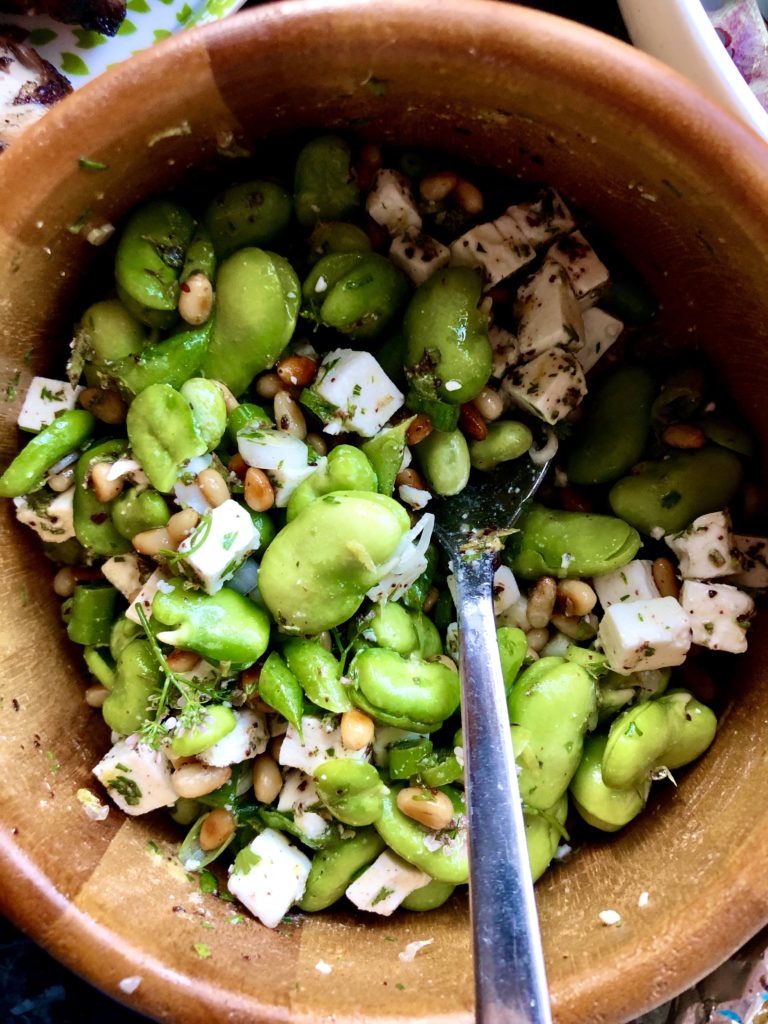
Ingredients (serves 2, scales up easily):
- 2 or 3 large handfuls of Broad Beans in their pods
- 125 g Feta cheese
- 25 g pine nuts, toasted (you could also use flaked almonds)
- 1 spring onion, trimmed and finely sliced on the round
- 1 tsp sumac
- Extra Virgin Olive Oil
- Sea Salt, Black Pepper
- 1 tsp of lemon zest and juice from 1/4 of a lemon
- Handful of herbs, roughly chopped: oregano and chive work well.
Method:
- Remove the beans from their pods, remove the skin. If the beans are small to medium sized and sweet, they can be eaten raw. Any bigger and I would recommend blanching for about a minute before refreshing in iced water. If the thought of eating raw beans isn’t for you, whatever the size of the bean, then do this too!
- Drain the beans, place into a bowl.
- Crumble over the feta cheese, add the spring onion.
- Toast the pine nuts (or flaked almonds) in a dry pan. Set aside to cool slightly.
- Sprinkle the Sumac over the beans and feta. Add a small pinch of sea salt (the feta will already be salty), and a grind of black peppercorns.
- Add the lemon zest and juice and a generous glug of EVO (about 1 tablespoon). Chuck in the herbs.
- Mix all together and serve.
Enjoy…with a nice glass of Chianti, maybe. Fuhfuhfuhfuhfuhfuh…!
Goat-Goat-Beet
Part of a collection of recipes I’m calling My Purple Passion
So, I hold a deep conflict when it comes to anything Goaty. If I ever have enough land to keep animals, the first thing on my list would be a goat. They are such lovely creatures – cantankerous but full of personality. When my parents used to live in the Welsh mountains, they had three Cashmere Mountain Goats called Flymo, Black and Decker – I know, you don’t need to say anything. Aside from my parents and their dogs, I always looked forward to seeing the goats. I’ve loved them ever since, but the thing is, I also adore their milk, yogurt, cheese and, yes its true, their meat.
In the past few years, goat meat has been appearing on menus here and there and across the country there are a small number of goat farms raising goats for their meat. It’s been hailed as a sustainable alternative to meat production and consumption, but it isn’t a cheap meat and, for the most part, producers in Ireland mostly service the restaurant industry. But, with Covid-19 that market has been lost to the producers and are focusing their efforts to sell direct to normal customers, like you and me, a lot more. This is great news for those who have been curious about working with goat meat, but found it difficult to source exceptional quality, Irish reared goat to cook with at home.
There is Broughgammon Farm in the north of country, and a scattering of others around the midlands. Down south is the wonderful Ballinwillin House in Mitchelstown, Co Cork. On this farm on an old estate, Pat and Miriam Mulcahy produce wild boar, venison, beef and goat meat all grass fed and semi-free range. Everything happens on site, including their own abattoir, butchery and smokehouse. In terms of production, it has virtually zero food miles – that and, of course, it is meat of the most exceptional quality.
Thanks, in part, to Covid-19, Ballinwillin House is now selling their produce through Neighbourfood – an excellent initiative that I have championed since the first collection day in the Old Apple Market in Cork city on a bitterly cold and wet winters’ evening in 2018. Ballinwillin are a newcomer to our corner of the world here, through Neighbourfood. Choosing items for my weekly order, I stumbled upon their Goat Salami. A lover of salami, you can imagine, I was immediately intrigued so that went in the cart. Then I spotted that the lovely Siobhan from St Tola Goats Cheese was also starting to sell that week, and her newest product, St Tola Divine, described as a fresh and creamy goats curd, also caught my eye, so that went in the cart too.
I had a suspicion that these two ingredients would be a dream together: the rich funkiness of the goat salami and the sweet silkiness of the goat curd. And what goes so well with goats cheese? Beetroot of course! And what goes well with beetroot? Fennel and Chili, naturally – a favourite flavour combo of mine that I discovered many years ago when I developed my classic Beetroot, Fennel and Chili Soup (check it out here!).
The only cooking in this dish really is steaming, peeling and slicing the beetroot. But look, if you can’t be bothered to do that you could substitute for those ready cooked and peeled vac-packed beets you can get in the supermarket these days, but you know I’ll always prefer to encourage people to buy beets that have been grown seasonally and locally because, frankly, there is no comparison on taste!
What I will say is this: this dish deserved its place in My Purple Passion collection of recipes. So simple, and so delicious served as a summery shared starter al-fresco in the late evening sunshine. Best served with fresh bread – we found a pillowy focaccia works best.

Ingredients – this will serve 6 – 8 people as a nibbly starter
- 100 g Ballinwillin House Goat Salami
- 30 g St Tola Divine Goats Curd
- 2 large fresh beetroot, steamed, peeled and thinly sliced
- 1 tsp Maldon sea salt
- 1/8 tsp fennel seed
- 1/8 tsp chili flakes
- Fresh thyme, leaves and flowers
- Extra Virgin Olive Oil
Method:
- If your beetroots come with their leaves still attached, remove them and save them to use as you would chard or spinach another time.
- I find steaming the beetroot whole works best as you don’t lose flavour and is a very gentle way of cooking. Depending on the size of the beetroots, this should take around 30 – 40 minutes. They need to be cooked through, but I prefer the beetroots to retain a small bit of bite to them, but you may prefer them softer still so then cook until completely tender all the way through.
- When cooked, allow the beetroots to cool slightly so you can handle them to peel them. I use a small pairing knife to scrape, rather than peel, the skins off. Top and tail and slice thinly using a knife or, if you have one, a mandoline.
- In a pestle and mortar, place the salt, fennel seed and chili flakes. Grind into a seasoned salt mix.
- Arrange the disks of beetroot on a platter and scattered all over with the salt mix.
- Arrange slices of the goat salami on top and add small dabs of St Tola Divine Goats Curd.
- Finally, dress with some fresh thyme leaves and flowers if you have them, (they are delightfully pinkish in hue too), and drizzle over with some great quality EVOO.
- Serve with focaccia bread, and a glass of crisp, dry white wine.
Enjoy!
Squash, Sage & Pork Carbonara
Apparently, 6th April is World Carbonara Day, and I’ve just finished reading this wonderful article by Manuela Spinelli of Eurotoques Ireland on the heart pounding merits of a good classic carbonara, and also reminding us that the principle of Italian cuisine is “generally three ingredients that marry together and become a paradise of flavours.” I shudder to think what Manuela would say to me on spying the mushrooms I love to put in my carbonara, along with parsley and the wrong kind of pork and cheese.
But as much as my Carbonara a la Anglaise may be derided for tearing up the Italian cuisine rule book, I feel quietly confident that the recipe below for a very un-Carbonara-like-Carbonara would warm the cockles of your heart all the same. Just like the real Italian classic, it has three primary flavours, but that aside, this would probably have Italians the world over rolling their eyes at my incredulity and arrogance, while also unable to deny the glorious flavour triumvirate that is Squash, Sage and Pork.

In these times of Covid-19, when more than ever nothing should be going to waste in the kitchen, this recipe was born from the necessity to use up a couple of sausages and half a butternut squash. There is also sage, one of my favourite herbs for chilly days, a gentle hit of chili, garlic (because: well, garlic…!), and some lemon to freshen the whole thing up. It’s a surprisingly easy dish to make, but apologise to the evening’s pot-washer in advance as it definitely isn’t a one-pot wonder!
Top Tip! This dish will feed two people with plenty of left over sauce. This sauce can be thinned out a little the next day and heated up, drizzled with some chili oil and crème fraiche and served up with some thick crusty bread for a hearty soup for one the following day!
Ingredients:
- Half a butternut squash, peeled and chopped into medium chunks
- 2 pork sausages, skinned and ripped into small bite sized pieces
- 1 clove of garlic, peeled and sliced
- Red chili: either a few dried flakes or some fresh – to taste, background heat only!
- Handful of sage herb, leaves only
- 1 tbsp of fresh lemon juice
- 1 tsp of sea salt
- Freshly ground black pepper
- Long pasta: either spaghetti or linguine
- Olive Oil and Extra Virgin Olive Oil
- Parmesan Cheese
Method:
- Steam the butternut squash until tender.
- Place a large pot of well salted water onto boil. Just as the butternut squash is tender throughout, place the dried pasta into the boiling water.
- Meanwhile, in a frying pan cook down the sausage meat in a little olive oil until browned and glistening. Take out of the pan and place on kitchen paper.
- Reserve the meat cooking juices in the frying pan, and cook slowly the sliced garlic. Drain and place onto a piece of kitchen paper.
- Just before the pasta is cooked, place the tender butternut squash into a blender with the garlic, chili, lemon juice, sea salt, a generous twist of pepper, most of the sage and remaining meat juices from the frying pan. Add a little dash of water, (I use the water from steaming to retain the flavour), to help it along and blitz until completely smooth. Set aside.
- Drain the cooked pasta and place back into the saucepan. Dress the pasta with some Extra Virgin Olive Oil and set aside.
- Back to the frying pan and fry off the remaining sage leaves until crispy. Drain on kitchen paper.
- Pour the butternut squash sauce over the pasta a little at a time to coat it thoroughly and luxuriously. Don’t worry if there is a lot of sauce left over – you can have that for lunch tomorrow!
- Portion out onto warmed plates, top with nuggets of the browned sausage meat, crispy sage leaves, a final flourish with the pepper grinder and plenty of grated parmesan cheese.
Enjoy with a chilled, crisp white wine!
Sweet Golden Lassi
My love for Lassi knows no bounds. I’d sooner have a Lassi over a milkshake, and of course they can be sweet or salty but always delightful.
It is currently Mango season, so I’m getting beautiful mangoes in my organic veg box regularly. And just like pears, rarely do they arrive in perfectly ripe condition, so there is an element of waiting for the perfect moment of peak ripeness. Use up the mangoes we must do, and having them in a Lassi is one of my favourite ways to enjoy them!
We are blessed in West Cork to have Gloun Cross Dairy on our doorstep (more or less, West Cork is bigger than you might think!) I adore their milk, their cream and their Buttermilk too. It’s proper stuff, thick and full of goodness with just about the most perfect texture for Lassi making! Because its February, and because our immune systems are screaming for sunshine and warmth, (still a good few weeks away yet), I added organic, whole turmeric root here. It helps to boost the golden, sunshiny colour, but also is a great immune booster, good for the gut and to help ward anyway any nagging aches and pains with its anti-inflammatory properties. Despite its colour, it’s not sweet, but earthy in flavour, so a little goes a long way!
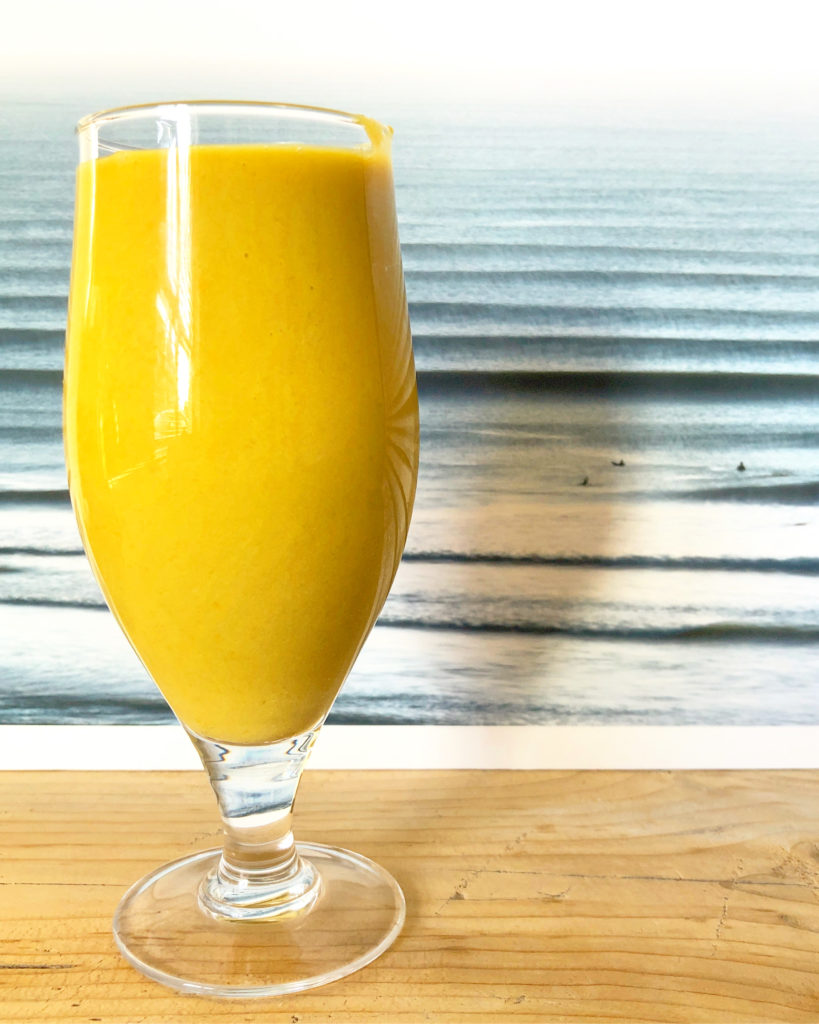
I added West Cork honey for some additional sweetness and goodness, and a little spritz of fresh lime juice just to enliven the natural acidity in the buttermilk to make the whole thing sing. Your blender does all the work for you, making this a perfect fuss free breakfast drink that sings of the warmer, sunnier days to come!
Time saving tip: keep ready to use frozen mango in your freezer, and simply add two handfuls to the blender!
Ingredients (makes 1 Lassi):
- 1 ripe mango, peeled and chopped;
- 2 cm piece of fresh turmeric root, peeled and grated (wash hands afterwards to prevent staining);
- 150ml of fresh Buttermilk;
- 2 tsp raw honey;
- Spritz of fresh lime juice;
Method:
- Place everything into a blender. Blend on high for 2 mins (or more if your blender is less powerful), ensuring everything has been well blended.
- Pour into a glass and consume with glee!
Enjoy…
Talking of mangoes… Dianne Jacob won the MFK Fisher award for her essay, The Meaning of Mangoes. Have a read of it HERE.
If you liked that, you might be interested to know that Dianne will be coming to West Cork in October this year to co-host a food writing workshop and food tour with yours truly called Food With a Story to Tell. Full event information and online booking can be found HERE …
Early Bird offer runs until 31st March 2020!
Something for the weekend…
There were whispers about things of beauty being brewed and bottled in West Cork; things of a very adult nature indeed. Made to majestically pair with crafted spirits, but equally good on their own as a grown up tipple. This is the world of Fintan’s – Small Batch Botanicals Handcrafted in West Cork.

Pamela Weaver and Janet Paterson are foodies and brewers – and from their home near Bantry in West Cork they have created a range of Botanical Syrups and Shrubs from exotic aromats and locally harvested berries.
Ireland is home to some ingenious small batch distillers, and for Pamela, it seemed disingenuous to their time and effort that there wasn’t an equally well-made mixer to pair with it.
Having gone as far as she could experimenting brewing beer at home, Pamela decided to try her hand at brewing tonics instead. The result is a small but beautifully curated range of Botanical Syrups and shrubs to compliment a craft spirit, or simply virgin, on its own, with some sparkling water as a refreshing adult-friendly non-alcoholic drink.
Having finally got my mitts on a bottle of each, I set about experimenting to see what goes well with each. I still haven’t cracked what to do with the Blackberry and Lime Shrub (my earlier attempts were lacking in something, so I have to return to it again!), but for Botanical Syrups 1 & 2 I am happy indeed with the results! The good news for you is that, like all my cocktail recipes, you don’t need any fancy kit to make them! So dive in, chin-chin, and set your watch to Cocktail O’Clock!
The range of Fintan’s come with a handy set of tasting notes. These helped enormously in identifying other flavours and craft spirits that I thought would work well with each.
Botanical Syrup No. 1 : Orange and citrus notes with an edge of tartness. Whole green cardamom and allspice berries round things out with a light spice note in the background.

By order of the king
Working the orange and cardamom hints and warming spicy background of Botanical Syrup No.1, I decided to bring it together with the rather superb Kinsale Mead Co’s Wild Red Mead, rich with tart berry flavours, and The King’s Ginger, a luxuriously warming ginger liqueur. The vanilla sugar dusted rim helps to soften the spices, heat, acidity and sweetness to give a pleasing finishing mouthfeel.
- 50ml Kinsale Mead Co Wild Red Mead
- 25ml Fintan’s Botanical Syrup No. 1
- 10ml The King’s Ginger
- 130ml Sparkling Water
- Vanilla Sugar and Orange to garnish.
- Muddle Mead, Syrup and King’s Ginger with slices of fresh juicy orange. Brush the rim of a glass with orange juice and dust with vanilla sugar. Strain and pour the mixture into the glass and garnish with orange.
Botanical Syrup No. 2 : Genuine cinchona bark gives this its classic, ultra-dry tonic notes. Wood and spice undertones complement the hit of quinine, with grains of paradise for a little pepper, rounded out with grapefruit and fennel.
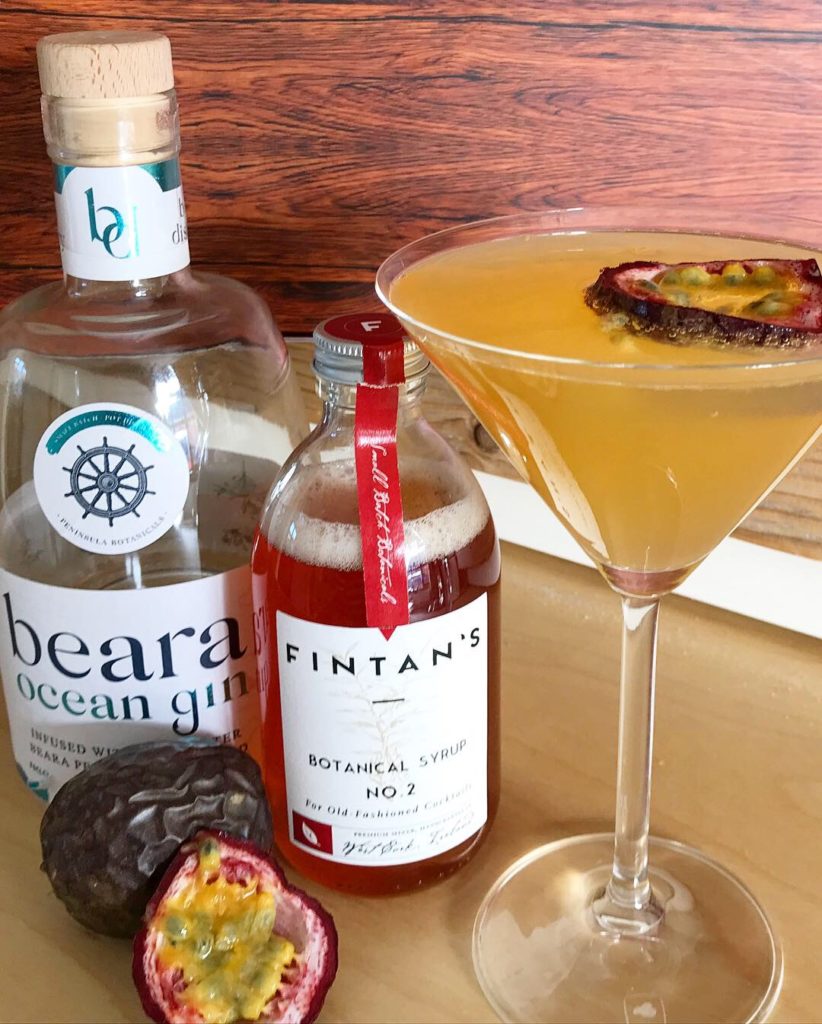
Fintan’s Passion
I knew that I wanted to pair Botanical Syrup No.2 with gin, and my favourite of all is Beara Ocean Gin. It is distilled from West Cork whey and flavoured with sea water, sea kelp and fuchsia botanicals among many others. I’ve always been drawn to gin and passionfruit as a winning flavour combination, and with the prevalent grapefruit coming from No. 2 syrup for me, this just made sense! This is a juicy, tangy and uplifting cocktail, suitably able to transport you to somewhere hot and full of palm trees…
- 50ml Beara Ocean Gin
- 25ml Botanical Syrup No. 2
- Seeds and juice from 2 passionfruits
- Sparkling water and passionfruit garnish
- Muddle and then shake together vigorously with ice cubes the gin, syrup and passionfruit. Strain and pour into a martini glass, top with sparkling water and garnish with a passionfruit round.
Liss Ard – the gem of gems in West Cork
There are many things I love doing with my down time: walking, eating great food, relaxing, playing with my dog, Buddy. I also love heading away for a spontaneous nights away in a lovely hotel to escape the everyday.
 As a committed dog parent, spontaneity isn’t always possible; because, like any responsible parent, we have to get a minder or beg, plead and borrow for a boarding kennel at 11th hour notice. But I do so love it when I can indulge in all the things I love about my down time and am able to combine it with an escape to the countryside where my pet is as welcome as I am, and then add all manner of bells and whistles and what you have is one of my favourite places of all time to walk, dine, relax and have adventures with Buddy, my dog. Welcome to Liss Ard Country House Estate.
As a committed dog parent, spontaneity isn’t always possible; because, like any responsible parent, we have to get a minder or beg, plead and borrow for a boarding kennel at 11th hour notice. But I do so love it when I can indulge in all the things I love about my down time and am able to combine it with an escape to the countryside where my pet is as welcome as I am, and then add all manner of bells and whistles and what you have is one of my favourite places of all time to walk, dine, relax and have adventures with Buddy, my dog. Welcome to Liss Ard Country House Estate.
 Liss Ard is less than five minutes’ drive from the bustling west Cork market town of Skibbereen. The elegant Georgian estate is nestled in 163 acres of gardens and peppered with unique vignettes such as James Turrell’s award winning Sky Garden. The elegant Country House, built in 1856, is hidden from view until arriving virtually at its doorstep. It has an immediate welcoming air, relaxed and dripping with understated luxury.
Liss Ard is less than five minutes’ drive from the bustling west Cork market town of Skibbereen. The elegant Georgian estate is nestled in 163 acres of gardens and peppered with unique vignettes such as James Turrell’s award winning Sky Garden. The elegant Country House, built in 1856, is hidden from view until arriving virtually at its doorstep. It has an immediate welcoming air, relaxed and dripping with understated luxury.
Liss Ard has changed hands many times in its 165 year history, but in the hands of the Stern Family based in Switzerland it is undergoing something of a renaissance.
 Since 2017, a small but ambitious chef team has been built busy reimagining what it means to be a restaurant in a hotel. Head Chef, Danny Barter, along with a young talented sous chef in Josh Graddon, have been garnering a reputation for
Since 2017, a small but ambitious chef team has been built busy reimagining what it means to be a restaurant in a hotel. Head Chef, Danny Barter, along with a young talented sous chef in Josh Graddon, have been garnering a reputation for 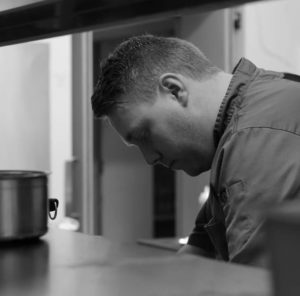 Liss Ard as an exciting and creative dining destination.
Liss Ard as an exciting and creative dining destination.
There are orchards, lakes, walled gardens and areas rich for collecting wild foods and mushrooms that grow in abundance in the grounds. In late Spring when the grounds reopen to the public, the woodland walks are carpeted in bluebells and the apple trees are heavy with blossom. But to really appreciate what Liss Ard has to offer, one simply has to stay and dine!
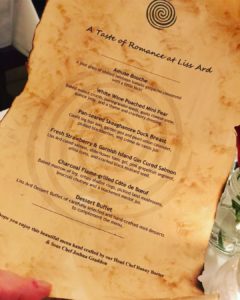 Throughout the year, Liss Ard host sumptuous dining events; tasting menus created by Danny and Josh and a welcoming experience curated by Aidan, Mags, Paul and David. Over the past two years, I have dined four times at Liss Ard, three times at their dining experience evenings. Most recently, Mr Flavour and I dined at their A Taste of Romance event on 16th February, two days post Valentine’s on a Saturday evening.
Throughout the year, Liss Ard host sumptuous dining events; tasting menus created by Danny and Josh and a welcoming experience curated by Aidan, Mags, Paul and David. Over the past two years, I have dined four times at Liss Ard, three times at their dining experience evenings. Most recently, Mr Flavour and I dined at their A Taste of Romance event on 16th February, two days post Valentine’s on a Saturday evening.
Segueway back to my dog, Buddy. Of course, you can stay in the human-friendly and rather grand surroundings of the Country House itself. The elegantly appointed rooms come with views and vistas of rolling green fields and beckoning forests as far as the eye can see. But where I love to stay is in the adjacent Mews Cottages; a handful of miniature houses-cum-apartments that open out into individual courtyards that back onto an expanse of immaculately kept lawn and head gardener, Sally’s, walled vegetable garden. These are Liss Ard’s pet-friendly cottages.
 These apartments are sleek and modern and full of the comforts of home so your pet can feel like they are having a holiday and adventure in a home from home! Where practically replaces opulence, quaintness, privacy and your own courtyard patch with seats for when the sun shines
These apartments are sleek and modern and full of the comforts of home so your pet can feel like they are having a holiday and adventure in a home from home! Where practically replaces opulence, quaintness, privacy and your own courtyard patch with seats for when the sun shines more than makes up for it. You and your pooch will love it – and that’s before they have even started to explore the numerate trails, paths and super-fun spots that will leave them with their legs walked off. Perfect timing, in fact, for when you settle them in for the night as you head across to the big house, the restaurant and an evening of delectatious dining!
more than makes up for it. You and your pooch will love it – and that’s before they have even started to explore the numerate trails, paths and super-fun spots that will leave them with their legs walked off. Perfect timing, in fact, for when you settle them in for the night as you head across to the big house, the restaurant and an evening of delectatious dining!
 We are welcomed by the site of something fizzy and giddy being poured into glasses, as the sounds of piano and violin echo through the galleries and spacious drawing rooms of the first floor. Ever since we arrived to check in, there have been deep, rich, meaty aromas drifting on the breeze, catching our noses and making our tummies gurgle with desire.
We are welcomed by the site of something fizzy and giddy being poured into glasses, as the sounds of piano and violin echo through the galleries and spacious drawing rooms of the first floor. Ever since we arrived to check in, there have been deep, rich, meaty aromas drifting on the breeze, catching our noses and making our tummies gurgle with desire.
We are called to dinner with a tinkling bell, and Aidan, the General Manager, requesting the pleasure of our company in the restaurant, situated downstairs. Tables are decorated simply but elegantly, and I am delighted to see that the tradition of tonight’s menu presented on an antiqued scroll is maintained. An amuse bouche to kick things off; a playful pear dish to start; followed by duck, gin cured salmon, charcoal flame-grilled Cote de Boeuf and a buffet assiette of desserts to finish. It was an outstanding menu, a great night, super comfortable stay and a brilliant breakfast the morning after too. Plus the opportunity to walk it all off and to head home full, happy with one delighted Buddy in tow too. Now, that’s how to make everyone jealous on a Monday morning when your colleagues ask you, “What did you do this weekend…”
Read on below for my best attempts at describing how wonderful each course was. By the time you’ve gotten to the end, you’ll be looking to book into their next event, or visit, or stay, or maybe start figuring out if maybe you could just live there forever…
Follow Liss Ard on social media to get first hand news of their dining experiences, or their fantastic value stay and play packages. Bring the kids; bring the dog – make the most of every second at this gem of all hidden gems in West Cork. Have a peak around… www.lissardestate.ie
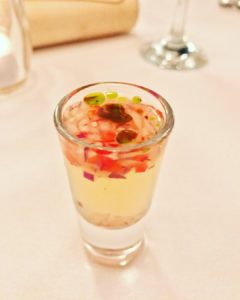 Amuse Bouche
Amuse Bouche
Our first course was a mouth tingling Gazpacho. A light and refreshing heirloom tomato water topped with red onion and chili and a drop of herb oil. The tingle of chili and onion really set our taste buds alight – we were ready for the next five courses!
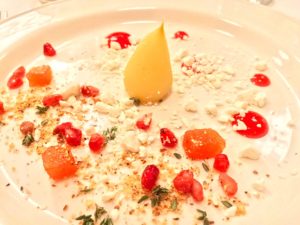 White Wine Poached Mini Pear with Baked Walnut Crumb, Pomegranate Seeds, Goats Cheese Snow, Quince Jelly, Thyme & Cranberry Dressing
White Wine Poached Mini Pear with Baked Walnut Crumb, Pomegranate Seeds, Goats Cheese Snow, Quince Jelly, Thyme & Cranberry Dressing
This was such a fun starter! The dainty look of the dish belied the great punchy flavours. The goats cheese snow melted creamily on the tongue – it’s the perfect time of year for super creamy fresh goats cheese as the new kidding season gets underway. Walnut and thyme are perfect partners to both the pear and goats cheese. It was the cranberry gel that was the delight of this dish though… candy sweetness with a hint of tartness seemed to be bring all the elements together harmoniously.
…you know that thing in a murder mystery where the person who did it is revealed at the end, turning out to be the person you didn’t even notice earlier in the movie? That’s what the cranberry was like here! I wasn’t sure if it would be a flavour too far, but in the end it was pivotal to everything else working together perfectly!
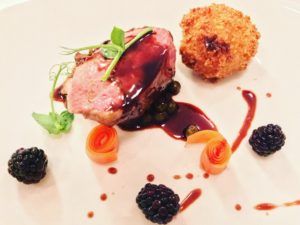 Pan-seared Skeaghanore Duck Breast, Confit Leg Bon Bon, Garden Pea and Pearl Onion Cassoulet, Pickled Blackberries and Creme de Cassis Jus
Pan-seared Skeaghanore Duck Breast, Confit Leg Bon Bon, Garden Pea and Pearl Onion Cassoulet, Pickled Blackberries and Creme de Cassis Jus
WOW! This was our favourite course of all – and that is something as the whole menu was epic last night!
Perfectly, and I mean PERFECTLY, cooked duck breast flavoured subtly with anise; the confit bonbon with a hint of bright orange zest, sweet pickled carrots and juicy bright pickled blackberries. A total triumph; but then the pea and pearl onion cassoulet licked with the deep, rich, sweet/sour jus provided a glorious bedrock for everything else on the plate to sing. There was nothing left on our plate after this – the cooking and flavour balance were spot on.
I loved that nothing was smoked here – something that seems to happen a lot these days as a “modern twist” on cooking duck, and although I am partial to a smoked meat or two, when duck is in the hands of a chef who understands how to cook duck right, it has a delicate flavour that can be easily overtaken by smoking. Here, this dish is all about quality of the primary ingredient – the duck, and the skill of cooking it with classic flavours put together in a well considered way. Nothing sticky or crying here – these flavours are fresh, light, clean and brilliantly balanced!
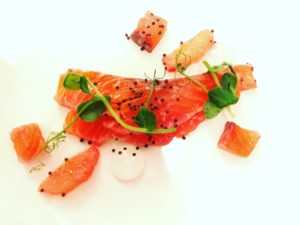 Fresh Strawberry & Garnish Island Gin Cured Salmon, Elderflower Tonic Gel, Pink Grapefruit and Black Mustard Seed
Fresh Strawberry & Garnish Island Gin Cured Salmon, Elderflower Tonic Gel, Pink Grapefruit and Black Mustard Seed
After such a rich dish previously, this light and refreshing fish course was a great way to refresh the taste buds!
Thick slices of house cured salmon had taken on the flavour of the floral Gin, and the tonic gel complimented perfectly, the quinine tang balancing the rich fattiness of the fish. Pink grapefruit both cleansed the palate and partnered with the tonic gel and gin cured salmon effortlessly. The black mustard seeds were an inspired change from black pepper offering both nutty flavour and mustard heat rather than just pepper heat! It’s all in the quality of that salmon.
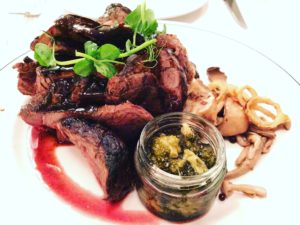 Charcoal Flame-Grilled Côte de Bœuf, Baled Marrow of Leg, Crispy Shallot Rings, Pickled Land Mushrooms, Broccoli Chutney, Blackened Merlot Jus
Charcoal Flame-Grilled Côte de Bœuf, Baled Marrow of Leg, Crispy Shallot Rings, Pickled Land Mushrooms, Broccoli Chutney, Blackened Merlot Jus
Be still my beating heart… Before this awesome plate of beefy loveliness was placed before us, we were asked if we would be happy for our meat to be served medium rare, and also that it would be served to share. This was when we started to get excited about what was coming!
Where to start… this was such a phenomenal tasting piece of beef. Started on a charcoal grill, the bark yielded unbelievable flavour, kicking off the malliard process and unlocking all that flavour potential in the marbling and aging. So perfectly pink, so so tender, layers of flavour and endlessly satisfying. The blackened merlot sauce was thick enough to glaze the meat adding extra umami. Crisp from shallots, zing from pickled but meaty mushrooms and an ingenious sweet broccoli chutney (broccoli still had plenty of bite – perfect!)
Frankly, the nicest piece of beef I have had in a long time. I love how the chef team@had taken the time to select an amazing prime ingredient at its peak and doing very little to it allowing it to stand by itself and take all the praise. It takes a confident chef to do that, to avoid over complicating something and running out the uniqueness that inspired a dish in the first place. We couldn’t finish it all, but insisted what was left was boxed up so we could take it away with us. Something this good should never be wasted! I want the recipe for that broccoli chutney, and if I only ate beef once a year from now on, this would be my beef dish of choice. So, so good! Bravo chef!
 Dessert Buffet: Raspberry Macaroon, Chocolate Mousse, Honeycombe Pieces; Lemon Meringue Tartlet; Cheesecake with Rhubarb Gel
Dessert Buffet: Raspberry Macaroon, Chocolate Mousse, Honeycombe Pieces; Lemon Meringue Tartlet; Cheesecake with Rhubarb Gel
I’m not quite sure how anyone else managed to eat one whole plate of these to themselves, they did, but we didn’t! Everyone of these miniature desserts were a delight, it’s hard to know which I enjoyed most! Was it the chewyness of the macaron against the velvety texture of the chocolate mousse; or maybe the marshmallowy Italian meringue or the vanilla rich cheesecake?
Ah, hell, it was all so good!! We did our best to demolish as much as we could and finished the whole thing off with a dram of West Cork Distillery bourbon cask finished Irish Whiskey. Put a fork in me, I’m done! Only thing left is to walk the whole thing off around the estate grounds!
 Buddy seal of approval! WOOF!
Buddy seal of approval! WOOF!
New Seasonal Prix Fixe Menu at Orso
Orso, tucked away on Pembroke Street in the heart of Cork city, is a restaurant that’s always on the “to go to” list for locals, and a delight to have stumbled upon as a first time visitor. Small but perfectly formed, Orso has never been afraid to bring something new and authentic to the discerning casual diners of the city.
 And as a lover of Levant cuisine myself (food from the region that stretches from the southern Mediterranean coasts of Spain, Italy, Greece and Turkey to the old Persian kingdoms of Iraq, Iran and Syria, and encompassing North East Africa, Palestine, Lebanon and Israel), I’m always delighted to settle in to eat. It is a cuisine that balances earthy and aromatic spices with an abundance of fresh herbs and punches of acidity from citric fruits both fresh and preserves. Charcoal vegetables, slow cooked meats, tangy yogurts and pillowy breads all amount to why Levant food is my favourite of all (second only to “Indian” food…).
And as a lover of Levant cuisine myself (food from the region that stretches from the southern Mediterranean coasts of Spain, Italy, Greece and Turkey to the old Persian kingdoms of Iraq, Iran and Syria, and encompassing North East Africa, Palestine, Lebanon and Israel), I’m always delighted to settle in to eat. It is a cuisine that balances earthy and aromatic spices with an abundance of fresh herbs and punches of acidity from citric fruits both fresh and preserves. Charcoal vegetables, slow cooked meats, tangy yogurts and pillowy breads all amount to why Levant food is my favourite of all (second only to “Indian” food…).
